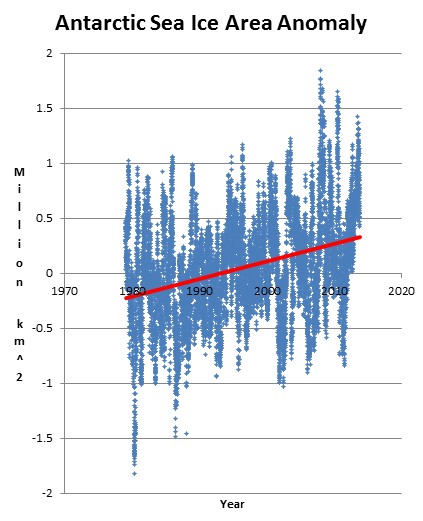And while Arctic ice has declined precipitously over the past thirty years of the satellite record, average Antarctic sea ice extent has stayed the same or even grown slightly.
NSIDC might want to review their second grade math skills. Global sea ice area has been above the 30 year mean most of the year, and is averaging above the 30 year mean. Antarctic ice area has grown by almost 10,000 Manhattans over the last 30 years.
arctic.atmos.uiuc.edu/cryosphere/timeseries.south.anom.1979-2008



The present rate of growth of the Antarctic ice anomaly is the highest since the space age records began, in 1979.
What’s happening now is “unprecedented”… as far as the records go! 😉
Its down to the wind
“Changing winds
Some research suggests that the changes in Antarctic sea ice—both where it is increasing and where it is decreasing—are caused in part by a strengthening of the westerly winds that flow unhindered in a circle above the Southern Ocean. “Antarctic sea ice is governed more by wind than by temperature,” said NSIDC lead scientist Ted Scambos. “The effects of climate change play out differently in the southern hemisphere than the northern hemisphere.”
Scientists say that this westerly wind pattern has grown stronger in recent years as a result of climate change. However, because Antarctic sea ice is so vulnerable to the changes in both the atmosphere and ocean, researchers are also looking at other climate patterns, such as the high latitude response to El Niño-Southern Oscillation, as well as the effects of changing ocean temperature and circulation, to understand how Antarctic sea ice is changing.
Stammerjohn and other scientists say that declining sea ice around the Antarctic Peninsula probably helps destabilize continental ice in that area by allowing the air above the ocean in that region to warm more than before. These continental ice areas are shrinking and therefore contributing to sea level rise. Stammerjohn said, “Though it is true that, on average, Antarctic sea ice is not changing, or even slightly increasing, the overall average hides a very large regional decrease that could have global consequences.””
BAS scientists also backed this up.
Homer – Arctic ice is also controlled by wind more than temperature
I don’t think the increased ice anomaly is caused by winds, it makes no sense in terms of “anomalies”, I think it’s caused by colder temperatures as evidenced by the data itself,
http://notalotofpeopleknowthat.wordpress.com/2013/09/09/satellites-confirm-antarctic-is-getting-colder/
and
http://bobtisdale.files.wordpress.com/2012/03/13-southern.png
Note that the temperature drop is evident despite the data manipulation that we all know happens in temperature records. Not only the temperature is dropping in Antarctica, the dropping rate is evidently increasing after the last solar minimum (between C23 and C24).
IPCC acknowledges that their “wind models” cannot explain what is happening,
” … their [IPCC] models forecast less ice, and they cannot explain why there is instead more ice. The fact that area is increasing even faster would suggest that the increase in extent is not due to winds spreading the ice out… “
http://notalotofpeopleknowthat.wordpress.com/2013/10/01/ipcc-on-antarctic-sea-ice/
They could understand, if wanted to, by trying to include solar forcing appropriately. The Antarctic ice is breaking record, after record of ice extent and colder temperatures,
http://notalotofpeopleknowthat.wordpress.com/2013/10/02/antarctic-sea-ice-breaks-more-records/
and
http://notalotofpeopleknowthat.files.wordpress.com/2013/09/image63.png
and some comments here,
http://westernusawx.info/forums/index.php?showtopic=33725&p=654207
In fact, the entire world’s temperatures are falling steadily since 2005,
http://icecap.us/images/uploads/cfsr_t2m_2005.png
But some people prefer to look at “models” instead of the real facts.
The Antarctic sea is not much more significant to understanding global warming than a heavy snow fall. It mostly melts back to its original starting point every summer. The real story is with the mile and half high glacer on top of much of a continent 50 percent bigger than the continental U.S.
Double ROFL.
So you think that the warmer ocean at lower latitudes and altitudes and freezing point is freezing, while the colder interior is melting.
Genius.
Government PR folks don’t do math. They just run up the bill and put it on our tab.
Steve, that article is from Jan 2012 so unless they had a Dr Who Tardis they were never going to make you happy on the ice extent this year
ROFL – The trend hasn’t changed in the last two years
It might be an impression viewing that time series, but could we have some kind of “pause” since around 2000 ? It may be interesting to compare (unadjusted) temperatures time series and ice-related data over the same periods in both hemispheres : by any chance, could there be some kind of north/south oscillation keeping a rough balance ?
I’ve seen literature going back to the 19th century which indicates that the poles tend to move out of phase. The 1990 IPCC report showed that SH lost ice in the 1970s while NH gained it..
Sun cycle 25 is going to be cold!
Steve, I didn’t say the Antarctic glacier was melting, just that all your focus on sea ice is missing the point. The Antarctic starts out 50 degrees colder than the Arctic so even with a little warming, things stay frozen. There are mostly unknowns with the main Antarctic glacer, but the penisular being more exposed to warmer water seems to be showing instability.